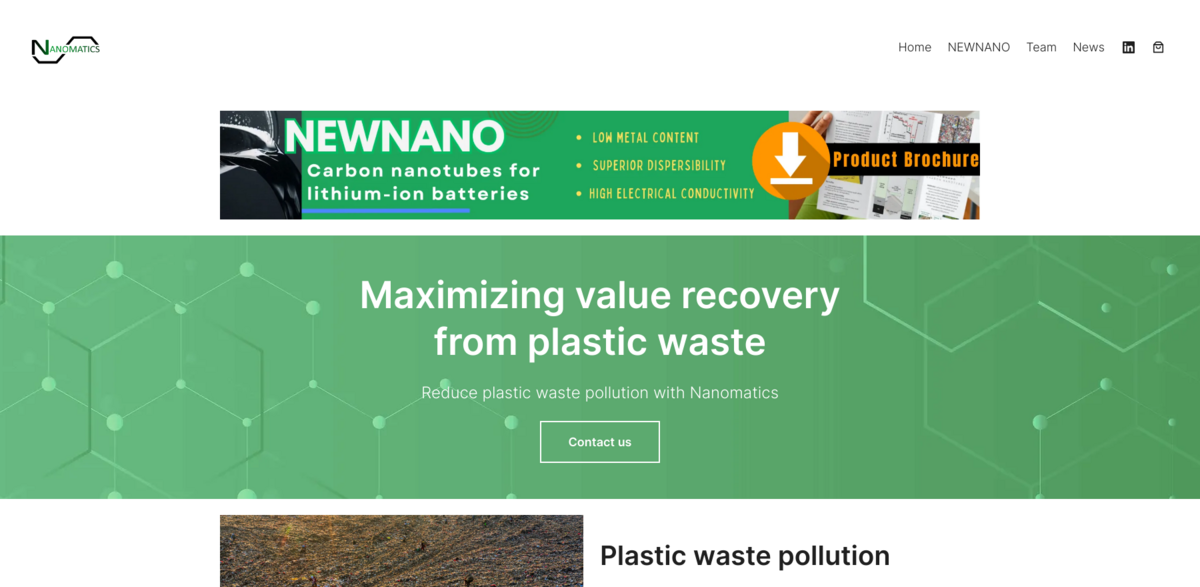What is the Nanomatics Project?
Nanomatics is a Singapore-based deep tech startup focused on tackling one of the biggest environmental challenges today: plastic waste pollution. Instead of relying on the usual incineration or landfilling methods, Nanomatics uses advanced thermal technologies to upcycle hard-to-recycle plastic waste into high-value products. This innovative approach transforms plastic waste into useful materials like multi-walled carbon nanotubes, hydrogen, and pyrolysis oil, creating a positive sustainability impact while supporting circular economy principles.
Main Benefits of Nanomatics’ Technology
Here’s a quick snapshot of what makes Nanomatics stand out:
- Over 90% of plastics today are non-recyclable due to contamination and processing challenges.
- Nanomatics’ process goes beyond traditional chemical recycling by producing specialty chemicals and strategic fuels.
- Multi-walled carbon nanotubes produced are used as additives in batteries, plastics, and coatings to boost conductivity, durability, and strength.
- Hydrogen generated can replace natural gas-derived hydrogen, supporting the energy transition toward net zero targets.
- The technology supports circularity by displacing products made from newly mined resources.
How Does the Upcycling Process Work?
The core of Nanomatics’ innovation lies in its thermal process, which consists of three main components: a thermal reactor, a chemical vapor deposition (CVD) reactor, and a hydrogen purification unit. This setup allows the conversion of plastic waste into pyrolysis oil, multi-walled carbon nanotubes, and hydrogen-enriched gas. It’s a clever way to extract maximum value from materials that would otherwise pollute the environment or end up in landfills.
Types of Plastic Waste Suitable for Upcycling
Nanomatics can handle a variety of plastic waste types, including:
- Polyolefin Resins: Polyethylene and polypropylene, commonly found in shopping bags, milk containers, bottle caps, trays, and other household items. These are excellent feedstocks for producing carbon nanotubes and hydrogen.
- Flexible Packaging: Includes bags, pouches, sachets, squeezable containers, films, and wraps. These have diverse polymer compositions, such as polyolefins, polyamides, polyesters, polyvinyl chloride, and polyvinyl alcohol.
- Marine Plastic Litter: Plastic debris from oceans, including straws, single-use utensils, packaging, bottles, labels, and fishing nets. These degrade into microplastics, posing serious ecotoxicity risks.
Carbon Nanotubes: A High-Value Product from Plastic Waste
One of the most exciting outcomes of Nanomatics’ process is the production of carbon nanotubes derived directly from plastic waste. These specialty chemicals are highly sought after as additives that enhance the performance of batteries, plastics, and coatings. By turning waste into such valuable materials, Nanomatics not only reduces pollution but also creates new economic opportunities in advanced manufacturing sectors.
Project Impact on Sustainable Development Goals (SDGs)
- SDG 12: Responsible Consumption and Production – Promotes sustainable management and efficient use of natural resources.
- SDG 13: Climate Action – Supports the reduction of greenhouse gas emissions through circular economy and clean energy solutions.
- SDG 14: Life Below Water – Helps reduce marine plastic pollution and its harmful effects on aquatic ecosystems.
- SDG 9: Industry, Innovation, and Infrastructure – Advances innovative technologies for sustainable industrial processes.
- SDG 7: Affordable and Clean Energy – Produces low-carbon hydrogen as a strategic fuel for the energy transition.
Why Nanomatics Matters in Today’s World
Plastic waste pollution is a massive global problem, with millions of tonnes of plastics ending up in landfills, incinerators, or polluting natural environments every year. Nanomatics offers a fresh perspective by turning this challenge into an opportunity. Their technology not only reduces environmental harm but also creates valuable products that support emerging industries and clean energy goals. It’s a win-win for the planet and the economy — proving that with the right innovation, waste can become a resource.





















